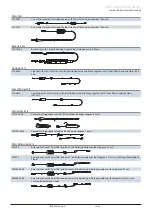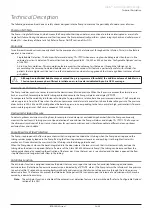
BDDF00160 Issue 1
38/40
Alaris™ GW Volumetric Pumps
Technical Description
Technical Description
The following details outline the basic safety checks designed into the Pump to minimise the possibility of under or over infusions .
Power on Self-Tests
The Pump is single fault tolerant, which means the Pump will either stop and alarm, or continue to infuse uninterrupted as a result of a
single fault failure . During the power on self-test sequence the Pump automatically performs system integrity checks and will alarm and
display
M
should any of these tests fail . Refer to 'Power On/Off' section of this DFU .
Air-in-Line
Two ultrasonic transducers continuously check for the presence of air in the Infusion set throughout the infusion . This air-in-line feature
operates in two modes:
• Single Bubble Detection - The Pump will alarm and display
J
whenever a single air bubble greater than the air in line
volume alarm limit is detected . The alarm limit can be configured to 50, 100, 250 or 500 µL . See also 'Configurable Options' section
of this DFU .
• Air-in-Line Accumulation - This accumulation feature monitors the volume of air that passes through the Infusion set by
accumulating the volume of individual bubbles over a 15 minute window . This feature is particularly useful with infusions for
patients that are highly sensitive to air (i .e . infants, paediatrics) or when infusing products that create significant volumes of small
air bubbles .
w
Although an individual bubble may not exceed the pre-programmed threshold, the additive volume of bubbles in a
15 minute volume may be sufficient to initiate an air-in-line alarm indicated by an Air OCCL message.
Downstream Occlusion Pressure
The Pump includes a pressure sensor to monitor the downstream Infusion pressure . When the IV pressure exceeds the alarm pressure
limit, as a result of, for example kinked IV tubing or blocked cannula, the Pump will alarm and display
P
.
To compensate for the variability in Infusion set tubing the Pump performs a relative, baseline pressure measurement . The Pump takes a
reference pressure from the IV line when the infusion commences and alarms at a preset limit above the baseline pressure . The pressure
alarm limits are 250, 350 and 500 mmHg above the baseline pressure, corresponding to the low, normal or high, pressure limits . To avoid
excessively large pressures the Pump is capped at 1000 mmHg .
Upstream Occlusion Pressure
To detect upstream occlusions resulting from, for example, closed clamps or occluded drip chamber filters the Pump continuously
monitors the upstream IV tubing pressure . Upon detection of an occlusion the Pump will alarm and display
J
. The Pump uses
the ultrasonic transducers of the air sensor to monitor for upstream occlusions and is therefore unable to differentiate an upstream
occlusion from an air bubble .
Pump Based Free Flow Protection
The Pump is equipped with a flow stop mechanism that is designed to occlude the IV tubing when the Pump door is open and the
tubing remains properly loaded in the Pump . Raising the flow stop mechanism lever arm and pushing it to the right activates this
mechanism . Once activated, the user inserts the IV tubing into the tubing guide channel .
When the Pump door is closed, the bevel integrated into the door releases the lever arm such that it will automatically occlude the
tubing when the door is re-opened . (Refer to 'Features of the Alaris GW 800 Volumetric Pump') The tubing can be removed from the
tubing guide channel by repeating the activation of the lever arm . Once the lever arm is re-activated and the door is opened, the flow
stop mechanism no longer occludes flow in the tubing .
Anti-Bolus Function
The anti-bolus function is designed to reduce the bolus that may occur upon the release of an occlusion following a downstream
occlusion alarm . (Detection of a downstream occlusion is indicated by a
P
alarm .) The Pump returns the Infusion set line pressure
to neutral within 15 seconds by pumping backwards briefly and measuring the Infusion set line pressure through the in-line pressure
detection system . This feature can prevent the fluid bolus to the patient that can occur upon the release of an occlusion, which may be
caused by a downstream clamp .
Note:
The anti-bolus function is disabled if the automatic set detection feature is to be switched off; refer to 'Configurable Options'
section of this DFU .


















